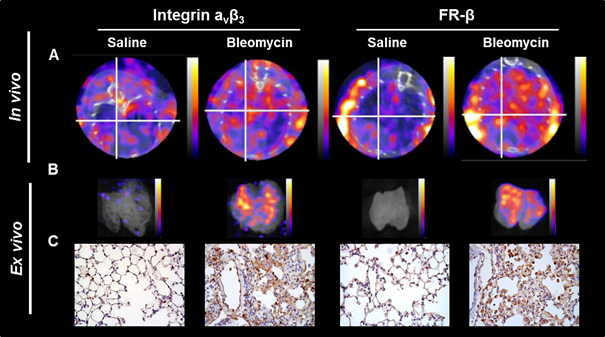Session Information
Date: Wednesday, November 16, 2016
Title: Systemic Sclerosis, Fibrosing Syndromes and Raynaud's – Pathogenesis, Animal Models and Genetics II
Session Type: ACR Concurrent Abstract Session
Session Time: 9:00AM-10:30AM
Background/Purpose: Interstitial lung disease (ILD) is one of the main causes of systemic sclerosis (SSc)-related deaths. Since routine diagnostics such as high resolution computed tomography and pulmonary function tests often only detect ILD at disease stages with already impaired organ function and/or damage, there is an unmet clinical need for the non-invasive diagnosis of ILD at earliest, still reversible stages. Here, we assessed new radiotracers for the detection of SSc-ILD specifically targeting integrin αvβ3 and folate receptor β (FR-β) as molecular players of inflammation and inflammation-dependent fibrosis in the murine model of bleomycin-induced lung fibrosis.
Methods: Expression of integrin αvβ3 and FR-β was analyzed in lung sections from patients with SSc-ILD, idiopathic pulmonary fibrosis (IPF) (n=5-6), healthy controls (n=4-5) as well as from bleomycin-treated mice and respective controls (n=6) using immunohistochemistry. In vivo imaging was performed using a RGD peptide derivative and a folate derivative radiolabeled with the gamma-radiation emitting radionuclide Lutetium-177 (177Lu). SPECT (single photon emission computed tomography) was performed using a dedicated small-animal SPECT/CT scanner. Animals were scanned at day 7 after intratracheal installation of bleomycin to visualize pulmonary inflammation and incipient fibrosis. The specific pulmonary accumulation of the radiotracer was confirmed by ex vivo SPECT/CT, biodistribution, and autoradiography studies.
Results: In lung sections of patients with SSc-ILD and IPF, the expression of integrin αvβ3 was significantly increased compared to healthy controls (p<0.009, p<0.02). In contrast, FR-β expression was only significantly upregulated in lungs from SSc-ILD (p<0.04), but not in IPF patients. In line with the results obtained in SSc-ILD, lungs of bleomycin-treated mice, but not of controls showed a significant increase in integrin αvβ3 expression and FR-β expression (p<0.03. p<0.05, Fig. C). Notably, at day 7 after intratracheal installation of bleomycin, SPECT/CT with 177Lu-RGD targeting integrin αvβ3, successfully visualized pulmonary inflammation and incipient fibrosis in the model of bleomycin-induced lung fibrosis. Similarly, SPECT/CT of FR-β showed a higher pulmonary uptake of the 177Lu-folate radiotracer in bleomycin-treated mice than in controls (Fig. A). Ex vivo SPECT/CT, biodistribution and autoradiography studies confirmed the in vivo results and validated the specific uptake of both radiotracers in lungs from bleomycin-challenged mice as compared to controls (Fig. B).
Conclusion: The here presented data provide evidence that targeting molecular players of inflammation and inflammation-dependent fibrosis using nuclear imaging methods may lead to a novel promising non-invasive approach for the early detection of lung involvement in SSc.
To cite this abstract in AMA style:
Schniering J, Haller S, Guo Z, Benesova M, Feghali-Bostwick CA, Schibli R, Distler O, Müller C, Maurer B. Targeted Nuclear Imaging for the Early Detection of Lung Involvement in Systemic Sclerosis [abstract]. Arthritis Rheumatol. 2016; 68 (suppl 10). https://acrabstracts.org/abstract/targeted-nuclear-imaging-for-the-early-detection-of-lung-involvement-in-systemic-sclerosis/. Accessed .« Back to 2016 ACR/ARHP Annual Meeting
ACR Meeting Abstracts - https://acrabstracts.org/abstract/targeted-nuclear-imaging-for-the-early-detection-of-lung-involvement-in-systemic-sclerosis/

